Something fishy about William Dyer
©
Christy K. Robinson
After the October 1651Navigation Act in Englandopened the door to a trade war with the Netherlands,Englandseized more than 120 Dutch ships over the next eight months. "The Dutchhave too much trade, and the English are resolved to take it from them," saidGeneral George Monck, Duke of Albemarle. The first of four Anglo-Dutch wars wasengaged. It was a naval war entirely, and was fought between 1652 and 1654. Themost famous battles took place in the North Sea waters between the Netherlands and the southeast coasts of England; however, privateer battles raged, twoships at a time, in the Caribbean and in Long Island Sound, south of New England.
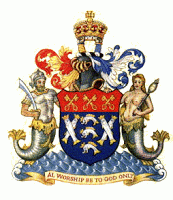 Arms of Worshipful Company of FishmongersWilliam Dyer (1609-1677) wasthe son of Lincolnshire farmers, and apprenticedto a Londonleather-goods trader in the Worshipful Company of Fishmongers for nine years.When he completed his service, you might consider his education on a par with aMaster's Degree in Business Administration, with emphasis in internationalimport/export. Many men who belonged to this Fishmongers guild had become London council membersand Lord Mayors.
Arms of Worshipful Company of FishmongersWilliam Dyer (1609-1677) wasthe son of Lincolnshire farmers, and apprenticedto a Londonleather-goods trader in the Worshipful Company of Fishmongers for nine years.When he completed his service, you might consider his education on a par with aMaster's Degree in Business Administration, with emphasis in internationalimport/export. Many men who belonged to this Fishmongers guild had become London council membersand Lord Mayors.
Dyer and his wife (MaryBarrett Dyer) emigrated to Bostonin 1635, but were excommunicated for their religious and political beliefs inearly 1638. Governor John Winthrop described William Dyer, at about age 25, as asuccessful businessman from London.Winthrop alsocalled Mary Dyer "Mistress Dyer," which carried a much higher status andrespect than the usual "goodwife" or use of the first name only. But later, Winthrop describedWilliam as "having little to say"for himself, and "apt to meddle inpublike affairs, beyond his calling and skill;" and that he shuffled and equivocated when underscrutiny.
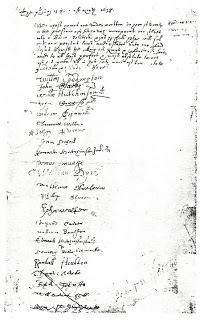
William Dyer co-founded Portsmouth and Newport, Rhode Island. (See image: Portsmouth Compact of 1638, probably in William Dyer's hand, as he was clerk and recorder. His signature is halfway down the page, as "William Dyre.")
Over the next fourteen years, William served as clerk and secretary to thecourts, and was a militia captain. From 1650 to 1653, he served as Rhode Island's first attorney general, and wasinstrumental in obtaining the colony charters for democratic self-governmentand separation of civil and church powers.
Dyer was commissioned NewEngland's first admiral in 1652 bySir Henry Vane the Younger, British naval commissioner and at times, Presidentof the Council of State when Great Britain was between monarchs during theCommonwealth and Protectorate.
On October 1, 1652, a letterwas written from the British naval commission to the Colony of Rhode Island in New England, to give them power to stay Dutch ships andto appoint some fit person to take care of and preserve them for the State.
As soon as Dyer returned to Rhode Island from England, he began to prepare forwar. Dyer, Nicholas Easton, and John Sanford created New England's first Court of Admiralty.And Admiral Dyer was chosen to be on a committee of seven to fortify and arm Newport. His large horseand tobacco farm property is now covered by the United States Naval War College.
On May 17, 1653, Dyer wascommissioned Commander in Chief Upon theSeas by the United Colonies of New England; and Captain John Underhill wascommissioned Commander in Chief Upon the Land. They were charged with thedefense of Englishmen from the Dutch, and to take ships by "inducement," but toprevent the effusion of blood, and violence. Dyer and Underhill "assisted both to other for ye preparings of ye severallseizures for the honor of ye Commonwealth of England in which theyare employed." They were to work in concert, at land and sea.
On June 3, 1653, Admiral Dyerwas commissioned by Rhode Island (Newport only, where hewas a resident neighbor, land-owner, businessman, politician, and well-known) asa privateer (a government-licensed pirate) with the charge to seize any Dutchproperties claimed by the English. The more-distanttowns of Providence and Warwick, however, filed "A BriefRemonstrance" to disassociate themselves from what they believed were "illegal and unjust proceedings" of Dyer and his privateers.
Dutch maps made before theAnglo-Dutch war of 1652-54 show they claimed a large chunk of Massachusetts,Rhode Island, all of Connecticut, New Hampshire—any place they could put atrading post, they claimed as Dutch territory. According to the Englishcolonies, the Dutch were bribing the Indian tribes to kill the Englishsettlers. This belief appeared to be confirmed in 1643 when Anne Hutchinson and17 members of her family and friends were killed by Indians when they lived ona Dutch farm in what is now the Bronx.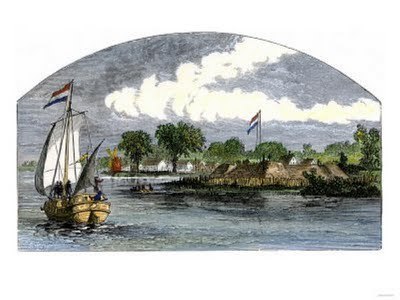 Ship passing House of Good Hope, at Hartford, Connecticut
Ship passing House of Good Hope, at Hartford, Connecticut
Among the first conquests ofDyer and Underhill was the Dutch West Indies trading post called House of GoodHope, on the Connecticut River at Hartford.In the Treaty at Hartford, September 19, 1650,between the Dutch and English, it had been agreed that the Dutch should remainin full possession of their lands on the fresh river at Hartford. But by the spring of 1653, theDutch trading post at Hartford,settled by Reverends Hooker and Stone, looked like shooting fish in a barrel. BothDyer and Underhill were extremely familiar with this property, and it appearsthat they may have had designs on it before their commissions were made.
Admiral William Dyer, age 44,was considered an opportunist, provocateur, and privateer by themembers of the United Colonies of New England—the very people who provided him withletters of marque! Along with Capt. John Underhill, he plundered Dutch andFrench ships and farms along the New Englandcoast, particularly Long Island Sound.
A number of ship captainssailed under the authority of Admiral Dyer, including Edward Hull and ThomasBaxter, both of whom eventually came up on charges of piracy and overtakingtheir authority. They had seized the ships, cargos, and seaside farms of Massachusetts, Connecticutand Long Islanders who were not Dutch—only Englishmen suspected of trading withthe Dutch. Baxter had lived in New Amsterdam,and so he knew which ships and farms to plunder. Hullhad lived in Barnstable, Massachusetts,as well as Connecticut, Block Island, and Newport, and knew theports and the ships that plied the waters. They would raid not only Dutch, butFrench and other nations' ships in an apparent zeal of "hostile takeover first,ask questions later—if you can catch me." Baxter was known for pirating Dutchpossessions, then dashing for cover in Connecticutor Rhode Islandrivers. His exploits set an example for other unscrupulous men, and soon theLong Island Sound was heavily patrolled against pirates. A historian laterwrote that the Sound was "infested" with small-time pirates.
Hull and Baxter were involved in other shady dealings overthe course of two or three years. They were later ordered to make restitutionand pay punitive damages. Baxter was imprisoned and handed back to the Dutch atNew Amsterdam (Manhattan Island), but after a yearof incarceration, he escaped.
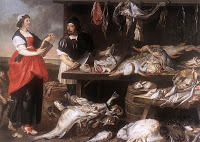 Loose fish in a Dutch fishmonger stallThomas Janvier, a historian,described Rhode Islandin those years and for many succeeding years, as "the abode of notoriously hard characters—even made a start on alittle war of spoliation on its own account." He referred to Capt. John Underhilland Admiral William Dyer as 'loose fishof thievish proclivities" with license from "that disreputable colony" [Rhode Island] to "take all Dutch ships and vessels as shallcome into their power."
Loose fish in a Dutch fishmonger stallThomas Janvier, a historian,described Rhode Islandin those years and for many succeeding years, as "the abode of notoriously hard characters—even made a start on alittle war of spoliation on its own account." He referred to Capt. John Underhilland Admiral William Dyer as 'loose fishof thievish proclivities" with license from "that disreputable colony" [Rhode Island] to "take all Dutch ships and vessels as shallcome into their power."
In the 1905 edition of The Dictionary of Phrase and Fable, byEbenezer Cobham Brewer, "Loose Fish" is defined as "A dissipated man. We alsospeak of a 'queer fish,' and the word 'fishy' means of very doubtful character.A loose fish is one that has made its way out of the net; and applied to man itmeans one who has thrown off moral restraint."
Thievish proclivities. Dissipated.Doubtful character. Rejected moral restraint. Hard characters. Fishy!
Though William Dyer is notoften mentioned as a man of firsts, and his wife Mary is much more famous asthe Quaker teacher who was hanged in Boston for her civil disobedience to thePuritan authorities, he did live a remarkable life as member of a prestigiousguild, a Boston pioneer, co-founder of Portsmouth and Newport, horse breeder,Newport harbor developer, international trader, militia captain, politician,Rhode Island's first attorney general, New England's first admiral andcommander in chief upon the seas, father of nine (seven of whom survivedinfancy)—and a licensed pirate. (Oh, dear!)
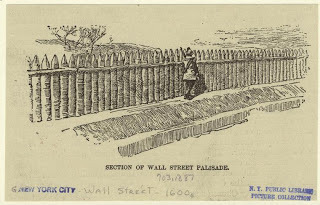 But there's one more thingyou should know about William Dyer: A meeting of the United Colonies noted thatDyre had 'quickly gathered around him a band of "resolute fellows" to fall onthe Dutch farmes.' New Amsterdam (now Lower Manhattan)built a defensive palisade across the island to defend themselves from land andsea raids by Indians and Englishmen (including the privateers under command ofDyer and Underhill). The wagon road running along the wooden palisade becameknown as Wall Street.
But there's one more thingyou should know about William Dyer: A meeting of the United Colonies noted thatDyre had 'quickly gathered around him a band of "resolute fellows" to fall onthe Dutch farmes.' New Amsterdam (now Lower Manhattan)built a defensive palisade across the island to defend themselves from land andsea raids by Indians and Englishmen (including the privateers under command ofDyer and Underhill). The wagon road running along the wooden palisade becameknown as Wall Street.
Wall Street: the spiritual home of corporate raiders. Oh,the irony.
 Arms of Worshipful Company of FishmongersWilliam Dyer (1609-1677) wasthe son of Lincolnshire farmers, and apprenticedto a Londonleather-goods trader in the Worshipful Company of Fishmongers for nine years.When he completed his service, you might consider his education on a par with aMaster's Degree in Business Administration, with emphasis in internationalimport/export. Many men who belonged to this Fishmongers guild had become London council membersand Lord Mayors.
Arms of Worshipful Company of FishmongersWilliam Dyer (1609-1677) wasthe son of Lincolnshire farmers, and apprenticedto a Londonleather-goods trader in the Worshipful Company of Fishmongers for nine years.When he completed his service, you might consider his education on a par with aMaster's Degree in Business Administration, with emphasis in internationalimport/export. Many men who belonged to this Fishmongers guild had become London council membersand Lord Mayors. Dyer and his wife (MaryBarrett Dyer) emigrated to Bostonin 1635, but were excommunicated for their religious and political beliefs inearly 1638. Governor John Winthrop described William Dyer, at about age 25, as asuccessful businessman from London.Winthrop alsocalled Mary Dyer "Mistress Dyer," which carried a much higher status andrespect than the usual "goodwife" or use of the first name only. But later, Winthrop describedWilliam as "having little to say"for himself, and "apt to meddle inpublike affairs, beyond his calling and skill;" and that he shuffled and equivocated when underscrutiny.

William Dyer co-founded Portsmouth and Newport, Rhode Island. (See image: Portsmouth Compact of 1638, probably in William Dyer's hand, as he was clerk and recorder. His signature is halfway down the page, as "William Dyre.")
Over the next fourteen years, William served as clerk and secretary to thecourts, and was a militia captain. From 1650 to 1653, he served as Rhode Island's first attorney general, and wasinstrumental in obtaining the colony charters for democratic self-governmentand separation of civil and church powers.
Dyer was commissioned NewEngland's first admiral in 1652 bySir Henry Vane the Younger, British naval commissioner and at times, Presidentof the Council of State when Great Britain was between monarchs during theCommonwealth and Protectorate.
On October 1, 1652, a letterwas written from the British naval commission to the Colony of Rhode Island in New England, to give them power to stay Dutch ships andto appoint some fit person to take care of and preserve them for the State.
As soon as Dyer returned to Rhode Island from England, he began to prepare forwar. Dyer, Nicholas Easton, and John Sanford created New England's first Court of Admiralty.And Admiral Dyer was chosen to be on a committee of seven to fortify and arm Newport. His large horseand tobacco farm property is now covered by the United States Naval War College.
On May 17, 1653, Dyer wascommissioned Commander in Chief Upon theSeas by the United Colonies of New England; and Captain John Underhill wascommissioned Commander in Chief Upon the Land. They were charged with thedefense of Englishmen from the Dutch, and to take ships by "inducement," but toprevent the effusion of blood, and violence. Dyer and Underhill "assisted both to other for ye preparings of ye severallseizures for the honor of ye Commonwealth of England in which theyare employed." They were to work in concert, at land and sea.
On June 3, 1653, Admiral Dyerwas commissioned by Rhode Island (Newport only, where hewas a resident neighbor, land-owner, businessman, politician, and well-known) asa privateer (a government-licensed pirate) with the charge to seize any Dutchproperties claimed by the English. The more-distanttowns of Providence and Warwick, however, filed "A BriefRemonstrance" to disassociate themselves from what they believed were "illegal and unjust proceedings" of Dyer and his privateers.
Dutch maps made before theAnglo-Dutch war of 1652-54 show they claimed a large chunk of Massachusetts,Rhode Island, all of Connecticut, New Hampshire—any place they could put atrading post, they claimed as Dutch territory. According to the Englishcolonies, the Dutch were bribing the Indian tribes to kill the Englishsettlers. This belief appeared to be confirmed in 1643 when Anne Hutchinson and17 members of her family and friends were killed by Indians when they lived ona Dutch farm in what is now the Bronx.
 Ship passing House of Good Hope, at Hartford, Connecticut
Ship passing House of Good Hope, at Hartford, Connecticut Among the first conquests ofDyer and Underhill was the Dutch West Indies trading post called House of GoodHope, on the Connecticut River at Hartford.In the Treaty at Hartford, September 19, 1650,between the Dutch and English, it had been agreed that the Dutch should remainin full possession of their lands on the fresh river at Hartford. But by the spring of 1653, theDutch trading post at Hartford,settled by Reverends Hooker and Stone, looked like shooting fish in a barrel. BothDyer and Underhill were extremely familiar with this property, and it appearsthat they may have had designs on it before their commissions were made.
Admiral William Dyer, age 44,was considered an opportunist, provocateur, and privateer by themembers of the United Colonies of New England—the very people who provided him withletters of marque! Along with Capt. John Underhill, he plundered Dutch andFrench ships and farms along the New Englandcoast, particularly Long Island Sound.
A number of ship captainssailed under the authority of Admiral Dyer, including Edward Hull and ThomasBaxter, both of whom eventually came up on charges of piracy and overtakingtheir authority. They had seized the ships, cargos, and seaside farms of Massachusetts, Connecticutand Long Islanders who were not Dutch—only Englishmen suspected of trading withthe Dutch. Baxter had lived in New Amsterdam,and so he knew which ships and farms to plunder. Hullhad lived in Barnstable, Massachusetts,as well as Connecticut, Block Island, and Newport, and knew theports and the ships that plied the waters. They would raid not only Dutch, butFrench and other nations' ships in an apparent zeal of "hostile takeover first,ask questions later—if you can catch me." Baxter was known for pirating Dutchpossessions, then dashing for cover in Connecticutor Rhode Islandrivers. His exploits set an example for other unscrupulous men, and soon theLong Island Sound was heavily patrolled against pirates. A historian laterwrote that the Sound was "infested" with small-time pirates.
Hull and Baxter were involved in other shady dealings overthe course of two or three years. They were later ordered to make restitutionand pay punitive damages. Baxter was imprisoned and handed back to the Dutch atNew Amsterdam (Manhattan Island), but after a yearof incarceration, he escaped.
 Loose fish in a Dutch fishmonger stallThomas Janvier, a historian,described Rhode Islandin those years and for many succeeding years, as "the abode of notoriously hard characters—even made a start on alittle war of spoliation on its own account." He referred to Capt. John Underhilland Admiral William Dyer as 'loose fishof thievish proclivities" with license from "that disreputable colony" [Rhode Island] to "take all Dutch ships and vessels as shallcome into their power."
Loose fish in a Dutch fishmonger stallThomas Janvier, a historian,described Rhode Islandin those years and for many succeeding years, as "the abode of notoriously hard characters—even made a start on alittle war of spoliation on its own account." He referred to Capt. John Underhilland Admiral William Dyer as 'loose fishof thievish proclivities" with license from "that disreputable colony" [Rhode Island] to "take all Dutch ships and vessels as shallcome into their power." In the 1905 edition of The Dictionary of Phrase and Fable, byEbenezer Cobham Brewer, "Loose Fish" is defined as "A dissipated man. We alsospeak of a 'queer fish,' and the word 'fishy' means of very doubtful character.A loose fish is one that has made its way out of the net; and applied to man itmeans one who has thrown off moral restraint."
Thievish proclivities. Dissipated.Doubtful character. Rejected moral restraint. Hard characters. Fishy!
Though William Dyer is notoften mentioned as a man of firsts, and his wife Mary is much more famous asthe Quaker teacher who was hanged in Boston for her civil disobedience to thePuritan authorities, he did live a remarkable life as member of a prestigiousguild, a Boston pioneer, co-founder of Portsmouth and Newport, horse breeder,Newport harbor developer, international trader, militia captain, politician,Rhode Island's first attorney general, New England's first admiral andcommander in chief upon the seas, father of nine (seven of whom survivedinfancy)—and a licensed pirate. (Oh, dear!)
 But there's one more thingyou should know about William Dyer: A meeting of the United Colonies noted thatDyre had 'quickly gathered around him a band of "resolute fellows" to fall onthe Dutch farmes.' New Amsterdam (now Lower Manhattan)built a defensive palisade across the island to defend themselves from land andsea raids by Indians and Englishmen (including the privateers under command ofDyer and Underhill). The wagon road running along the wooden palisade becameknown as Wall Street.
But there's one more thingyou should know about William Dyer: A meeting of the United Colonies noted thatDyre had 'quickly gathered around him a band of "resolute fellows" to fall onthe Dutch farmes.' New Amsterdam (now Lower Manhattan)built a defensive palisade across the island to defend themselves from land andsea raids by Indians and Englishmen (including the privateers under command ofDyer and Underhill). The wagon road running along the wooden palisade becameknown as Wall Street. Wall Street: the spiritual home of corporate raiders. Oh,the irony.
Published on September 01, 2011 01:00
date newest »
newest »
 newest »
newest »
 Hi, Mary.
Hi, Mary. William Dyer was a man of his time. I think his character was far more honorable than characters of the men of Massachusetts Bay and Plymouth Colonies who put out murder contracts on their enemies. With all the public-service jobs he performed, he deserved a larger footprint in history than he got (until I resurrected him for the Dyer blog).
As far as sharing the article, you are *welcome* to share the link to that article or to the entire blog, but please do not copy/paste the articles, because they are copyrighted. I need the pittance I get from advertising and page views, and I need to advertise my books. It's my living, you understand, not a hobby.
https://marybarrettdyer.blogspot.com/...
Yes, I'm descended from William and Mary Dyer. Thank you for your compliment, distant cousin.
Christy K Robinson




Mary